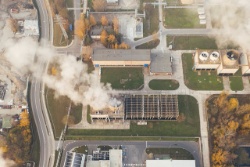Smart NZ Economy Could Grow 10% PA Says 'Father of Grid'

www.MulticoreWorld.com
New Zealand Economy Could Grow by 10% a Year through Clever Use of New IT Says Multicore World 2013 Keynote Address by Director of Computation Institute of Chicago University, Prof Ian Foster
Press Release - Friday, 1 February 2013
Multicore World 2013
Multicore World 2013’s opening key note from Professor Ian Foster (Argonne Laboratory, University of Chicago[*]) on ‘How to grow the economy by 10% per year’[*] is alone worth registering for the two day February event, says Multicore World 2013 founder Nicolas Erdody.
"Attendance at the 19 & 20 February conference and think-tank - which will discuss the impact of greatly increased computing power - should be compulsory for government, industry and anyone who is seriously interested in the future of New Zealand," says Erdody.
“Multicore and parallel programming are here to stay. This is a permanent change that has the potential to underpin a greatly enhanced IT offering.
"New Zealand could, if we think strategically, be a place where new techniques, platforms and processes are originated and developed in collaboration with the rest of the world. We can be a creative environment where New Zealand technologists can help the rest of the world by exporting solutions at the leading edge of multicore.”
The opening keynote speech by Professor Ian Foster, Director of the Computation Institute, a joint unit of Argonne National Laboratory and the University of Chicago outlines why he believes a country such as New Zealand can grow its economy by 10% a year.
“Economic growth is driven by the evolving interplay between innovation and automation,” says Foster, often globally acknowledged at ‘the father of the grid’, on his abstract.
“The former provides new products and services and the latter enables cost-competitive and timely production and delivery. Information technology plays an increasingly central role in this process – a role that is only going to accelerate in the next decade as a result of advances in cloud and multicore computing. I discuss the challenges and opportunities inherent in a hyper-connected, hyper-automated world, with a particular emphasis on what they mean for the wonderful country of New Zealand.”
Erdody says the quality of the international line up of speakers is easily the equal of any established northern hemisphere conference on computing, and an extremely cost effective way for IT professionals and others to understand and take advantage of this technology tsunami.
“We should ask ourselves why are these top-notch speakers deciding to come to New Zealand, some of them crossing the equator for the first time, when they can fill auditoriums anywhere?”, asks Erdody. “What do they believe that we can do from here?”
“The learning, the interactions, the business and deal-making connections we saw at Multicore World 2012 will only be enhanced at this year’s event.”
“New Zealand IT's future thinkers should be at this event. Our country has an opportunity to be a niche participant in industries based on multicore technologies, and rather than being swamped by this wave, we have the prospect of riding on its development,” says Erdody.
“Given that Callaghan Innovation is springing into life, Ian Foster’s proposal of growing a clever economy at 10% a year should ring very true and he would like to discuss it with key players in the New Zealand innovation sector in our forums during Multicore World 2013.”
Other speakers include Intel’s Tim Mattson , IBM’s Linux CTO Paul McKenney and FreeBSD’s Poul-Henning Kamp.


 Commerce Commission: ComCom Warns Of Pyramid Schemes After South Auckland Scammers Plead Guilty
Commerce Commission: ComCom Warns Of Pyramid Schemes After South Auckland Scammers Plead Guilty MBIE: MBIE Publish Mid-Point Review Of The Phase-Out Of The Low Fixed Charge (LFC)
MBIE: MBIE Publish Mid-Point Review Of The Phase-Out Of The Low Fixed Charge (LFC) Science Media Centre: Company Claims To Have “De-Extincted” The Dire Wolf – Expert Reaction
Science Media Centre: Company Claims To Have “De-Extincted” The Dire Wolf – Expert Reaction Stats NZ: Greenhouse Gas Emissions Fall 2.0 Percent In The December 2024 Quarter
Stats NZ: Greenhouse Gas Emissions Fall 2.0 Percent In The December 2024 Quarter The Reserve Bank of New Zealand: Christian Hawkesby Appointed As Governor Of The RBNZ
The Reserve Bank of New Zealand: Christian Hawkesby Appointed As Governor Of The RBNZ Kiwi Economics: It’s Mayhem In Markets As Downside Risks Dominate Following Trump’s Tariffs
Kiwi Economics: It’s Mayhem In Markets As Downside Risks Dominate Following Trump’s Tariffs



